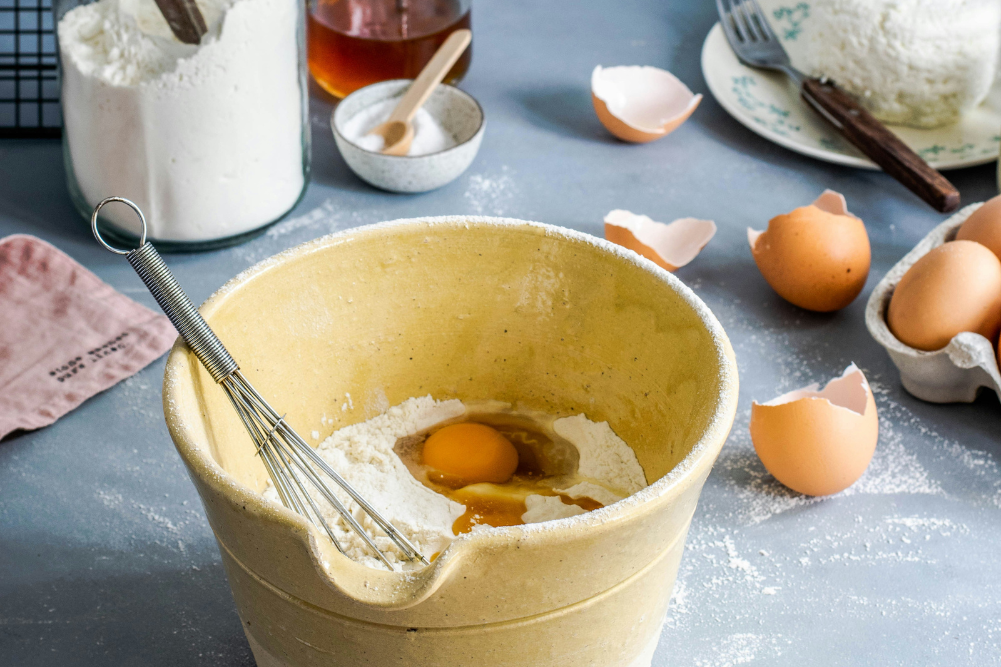Master gluten-free baking with expert tips on flour, moisture, and technique for perfect, airy treats. Say goodbye to grainy bakes!
We all love our baked treats but for people who have coeliac disease or are gluten intolerant, these gluten-full goodies can have detrimental impacts on their health and wellbeing. Coeliac disease is an autoimmune condition, which causes inflammation and pain in the gut when sufferers consume products containing gluten. Gluten is a protein found in certain grains such as rye, wheat and barley.
When used in cooking, gluten can provide added structure and improve the elasticity of a batter by trapping the air released by leavening agents like baking powder, baking soda and yeast, which allows them to rise. Without gluten, these recipes can have a grainy and stodgy consistency rather than the light and fluff y structure which is usually desired.
Fortunately, gluten-free cooking has come a long way recently with a plethora of alternative gluten-free ingredients to stock your pantry with. For some recipes, it’s as easy as a simple switch to gluten-free flour, but for other baking recipes it can be more complex. With proper planning, practice and the right ingredients in your pantry, you can say goodbye to crumbly, cardboardy and grainy cakes and bakes forever. Whether you’re a coeliac, gluten intolerant or just opting for a gluten-free diet, here are some tips you can use to master the art of gluten-free cooking in no time.
Switch to gluten-free flour
There are plenty of alternative gluten-free flours on the market to get acquainted with. The list of alternative flours can be overwhelming, so cover the basics first. A quality gluten-free all-purpose flour is a good place to start. This works as a substitute to traditional all-purpose wheat flour. These flours are designed to be used as a simple 1:1 swap with traditional gluten recipes. Available at most supermarkets and health food stores, these gluten-free flour blends contain a mix of gluten-free flour and a stabiliser/binder, which helps add structure to baking. It’s important to note that not all gluten-free flours are created equal. Different brands can produce varying results according to the ingredients used, so it’s best to experiment with a few until you find the one which you’re most comfortable with in each recipe.
When you’re feeling more confident, you can experiment with single gluten-free flour. Just remember not to substitute a single gluten-free flour such as almond flour with an all-purpose flour in a recipe without adding an accompanying binder or stabiliser. The goal is to mimic the properties of gluten to add more structure and elasticity to the final product. There are plenty of single gluten-free flours available, including buckwheat, coconut, rice, almond, tapioca and millet, all of which have different purposes depending on the type of recipe used and the desired taste and texture.
With its distinct earthy texture, amaranth flour is best used for savoury dishes such as pizza dough, while rice flour has a more delicate texture making it more suitable for pastries, cakes and cookies. Tapioca is a great thickener and can provide baked goods such as brownies and cakes with a lovely chewiness, while almond flour is a protein-rich flour that’s great for low-carb baking and recipes like brownies and cakes, which lend themselves to a fudgier texture. Oat fl our is also a great option since it has a mild, neutral flavour and a soft, starchy nature.
Bake by weight
Baking is a science, but gluten-free baking requires even more precision and accurate measuring. Gluten-free fl ours are notorious for their variation in weight, volume and grind size compared to their gluten alternatives, so they are much less forgiving. Say goodbye to your measuring cups and hello to an accurate kitchen scale where you can precisely measure by grams. Your recipes will thank you
Add More Moisture
To avoid the dry, brittle and crumbly trap often associated with gluten-free bakes, add more moisture to compensate. An extra egg white is a good place to start, this additional protein can make the batter more stable. Other alternatives to experiment with include fruit purees such as apple sauce or mashed banana in place of some of the liquid. Use ingredients that will retain more moisture like brown sugar as an alternative to granulated sugar or honey and maple syrup as a substitute for white sugar. Dairy products such as milk, sour cream and yoghurt are also effective and help provide more of a moist crumb. Where possible, opt for full-fat dairy rather than skinnier versions to help enhance the moisture content and add softness to the dish.
Bake for Longer and Lower
Gluten-free recipes have a habit of burning quicker than traditional gluten recipes as they require more liquid in the batter. A good rule of thumb is to lower the oven temperature a little and extend the baking time to evaporate the excess moisture and avoid the recipe becoming too mushy or falling apart.
Gluten versions of recipes often rely on visual cues such as “golden” or “slightly brown” to dictate if they are cooked. However, it’s often difficult to tell when a gluten-free bake is cooked just from observing the outside. When baking bread or a cake, use a thermometer to test the bake or even a toothpick or skewer inserted in the middle.
Incorporate a Binder
Gluten binds ingredients together, so it’s essential that gluten-free recipes use a substitute to take on this role if you’re not using a store-bought gluten-free fl our blend. There are plenty of options which can be used as magical binding agents including xanthan gum, agar gum and gelatine.
Xanthan gum is one of the most effective binders in gluten-free cooking and helps create a light and airy batter. It is made by fermenting corn sugar with bacteria to make a powder that acts as a great thickener. Just make sure to use it sparingly since it may make the mixture too dense and gelatinous. You will need approximately half a teaspoon of xanthan gum for every cup of fl our, but this will vary depending on the recipe used.
Psyllium husk is also a plant-derived natural fi bre that can help add structure to gluten-free breads and pastries. It forms a sticky elastic gel when mixed with liquid, which helps trap gas bubbles as the yeast expands. Similarly, starches including corn, potato and tapioca help add softness to a batter and work well in puddings and desserts.
When converting recipes, it’s a good idea to increase the quantity of leavening/raising agents like baking powder or baking soda by up to 25 per cent. You can also experiment with replacing full-fat milk with buttermilk or add a drizzle of apple cider vinegar to further activate the leavening agent.
Whip it real good
Unlike traditional gluten recipes, you don’t need to worry about overmixing a gluten-free batter. In fact, gluten-free recipes can benefi t from a longer mix time since fully combining the ingredients can help to provide more structure and encourage the bake to rise more by adding as much air as possible.
Eggs are a great way to achieve a fl uffi er texture and avoid a tough batter. A good way to do this is to separate the egg yolks and beat the whites until they form soft peaks, then gently fold them into the batter.
When it comes to bread, gluten free bread dough will look a lot stickier in comparison and can be a lot harder to work with. The good news is that no kneading is required for gluten-free recipes since the kneading process is not required to develop the gluten.
Rest Up
Patience is key when cooking without gluten, so it’s important not to rush the process. Whether you’re making a cake, pancakes or chocolate-chip cookies, gluten-free batters need to rest, particularly those that have a short bake time. Allow the batter to rest at room temperature for at least 10 to 15 minutes before baking. This allows the batter to soften, hydrate and absorb as much moisture as possible. This will help the bake have a better structure, rise and texture. The same rule applies to resting after baking. It’s a good idea to allow the recipe to cool completely before cutting or slicing it to reduce the possibility of it falling apart.
Get to room temperature
For best results, ensure your ingredients are at room temperature before beginning a recipe (including milk, eggs, butter and fruit purees). It is much easier to whip air into warmer ingredients for a fluffier, lighter result, and the extra warmth also helps the bake rise more effectively.
Also, remember that gluten-free recipes tend to have a lot shorter shelf life in comparison to the gluten versions. Happy baking!

